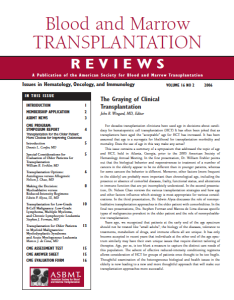 The Graying of Clinical Transplantation
The Graying of Clinical Transplantation
by John R. Wingard, Editor
For decades transplantation clinicians have used age in decisions about candidacy for hematopoietic cell transplantation (HCT) It has often been joked that as transplanters have aged the “acceptable” age for HCT has increased. It has been assumed that age is a surrogate for likelihood for transplantation morbidity and mortality. Does the use of age in this way make any sense?
This issue contains a summary of a symposium that addressed the topic of age and HCT, held in Atlanta, Georgia, prior to the 2005 American Society of Hematology Annual Meeting. In the first presentation, Dr. William Ershler points out that the biological behavior and responsiveness to treatment of a number of cancers in the elderly appear to be no different than in younger patients, whereas for some cancers the behavior is different. Moreover, other factors (more frequent in the elderly) are probably more important than chronological age, including the presence or absence of comorbid diseases, frailty, functional status, and alterations in immune function that are yet incompletely understood. In the second presentation, Dr. Nelson Chao reviews the various transplantation strategies and how age and other factors influence which strategy is most appropriate for various considerations. In the third presentation, Dr. Edwin Alyea discusses the role of nonmyeloablative transplantation approaches in the older patient with comorbidities. In the final two presentations, Drs. Stephen Forman and Marcos de Lima discuss specific types of malignancies prevalent in the older patient and the role of nonmyeloablative transplantation.
Years ago, we recognized that patients at the early end of the age spectrum should not be treated like “small adults”; the biology of the diseases, tolerance to treatments, metabolism of drugs, and immune effects all are unique. It has only become accepted in recent years that individuals at the other end of the age spectrum similarly may have their own unique issues that require distinct tailoring of therapies. Age, per se, is too blunt a measure to capture the distinct care needs of this population. The advent of effective reduced-intensity conditioning regimens allows consideration of HCT for groups of patients once thought to be too fragile. Thoughtful examination of the heterogeneous biological and health issues in the elderly is now leading to a new and more thoughtful approach that will make our transplantation approaches more successful.
Download a PDF version of the full issue.
